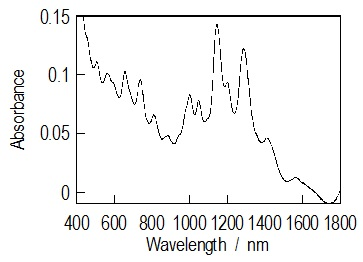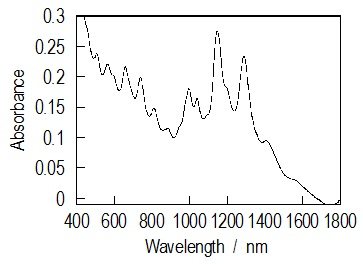Published TCIMAIL newest issue No.198
Maximum quantity allowed is 999
Merci de sélectionner la quantité
CAS RN: 1296211-78-3 | Numéro de produit: E1127
4,4'-[1,2-Ethenediylbis(4,1-phenyleneiminocarbonyl)]bis(N-butyl-N,N-dimethylbenzenemethanaminium) Dichloride
![4,4'-[1,2-Ethenediylbis(4,1-phenyleneiminocarbonyl)]bis(N-butyl-N,N-dimethylbenzenemethanaminium) Dichloride Chemical Structure of 4,4'-[1,2-Ethenediylbis(4,1-phenyleneiminocarbonyl)]bis(N-butyl-N,N-dimethylbenzenemethanaminium) Dichloride](/medias/E1127.jpg?context=bWFzdGVyfHJvb3R8MzQ1MzJ8aW1hZ2UvanBlZ3xhRFl3TDJnMk1DODRPVEl4TmpJek5EazBOamcyTDBVeE1USTNMbXB3Wnd8ZGY1MjQ0ODE3YjM5MTg3MTRiNTVjYjUyZDM0OGY5ODUzMGFjMzYzNWQxNTE4Y2FmYmIxOTNhNDkyNTFhNmExOA)
Pureté: >94.0%(T)
Synonymes
Documents de produit:
| Taille | Prix unitaire | Belgique | Japon * | Quantité |
|---|---|---|---|---|
| 1G |
€125.00
|
Contactez-nous | 36 |
|
*Le délai de livraison pour des produits disponibles en stock en Belgique est 1 à 2 jours
*Le délai de livraison pour des produits disponibles en stock en Japon est 1 à 2 semaines (sauf des produits réglementés et des envois avec de la glace carbonique)
| Numéro de produit | E1127 |
Pureté / Méthode d'analyse 
|
>94.0%(T) |
| Formule moléculaire / poids moléculaire | C__4__2H__5__4Cl__2N__4O__2 = 717.82 |
| Etat physique (20 ° C) | Solid |
Condition de stockage 
|
Room Temperature (Recommended in a cool and dark place, <15°C) |
| Condition à éviter | Light Sensitive |
| CAS RN | 1296211-78-3 |
| Numéro de registre de Reaxys | 22634941 |
| Identifiant de la substance PubChem | 354333621 |
Spécifications
| Appearance | White to Yellow to Green powder to crystal |
| Purity(Nonaqueous Titration) | min. 94.0 % |
Propriétés
SGH
| Pictogramme |

|
| Mot de signal | Attention |
| Mentions de danger | H315 : Provoque une irritation cutanée. H319 : Provoque une sévère irritation des yeux. |
| Conseils de prudence | P264 : Se laver la peau soigneusement après manipulation. P280 : Porter des gants de protection/ un équipement de protection des yeux/ du visage. P302 + P352 : EN CAS DE CONTACT AVEC LA PEAU: Laver abondamment à l’eau. P337 + P313 : Si l'irritation oculaire persiste: consulter un médecin. P362 + P364 : Enlever les vêtements contaminés et les laver avant réutilisation. P332 + P313 : En cas d'irritation cutanée: consulter un médecin. |
Lois connexes:
Informations de transport:
| N ° SH (import / export) (TCI-E) | 2924297099 |
Application
Single-Walled Carbon Nanotube (SWCNT) Dispersant
E1127 has strong interaction to the surface of single-walled carbon nanotube (SWCNT), and the positive charge on the stilbene core enables SWCNT to disperse in aqueous solution. UV irradiation makes closure of the stilbene moiety and elimination from the SWCNT surface which enables SWCNT to aggregate. After the aggregation, the dispersant can be easily removed by filtration, etc.
(1) Preparation of dispersions (Low power sonication)
3.6 mg of E1127 was dissolved in 3 mL of pure water (18.8 MΩ·cm, TOC < 3 ppb) or D2O using a glass vial (ca. 0.12 wt%). The solution was then sonicated (80 W, 35 kHz) at room temperature. Heating by a dryer is also a useful method for solvation. 1.96 mg of SWCNTs was added into the solution of E1127. The E1127/SWCNT mixture was sonicated (80 W, 35 kHz, 1 h) at room temperature. The black-colored dispersion was then centrifuged to remove impurities such as amorphous carbons and metal particles (28500 x g, at 22 °C, 3 hrs). Upper 70 % of supernatant was corrected as a well-dispersed SWCNT dispersion.
3.6 mg of E1127 was dissolved in 3 mL of pure water (18.8 MΩ·cm, TOC < 3 ppb) or D2O using a glass vial (ca. 0.12 wt%). The solution was then sonicated (80 W, 35 kHz) at room temperature. Heating by a dryer is also a useful method for solvation. 1.96 mg of SWCNTs was added into the solution of E1127. The E1127/SWCNT mixture was sonicated (80 W, 35 kHz, 1 h) at room temperature. The black-colored dispersion was then centrifuged to remove impurities such as amorphous carbons and metal particles (28500 x g, at 22 °C, 3 hrs). Upper 70 % of supernatant was corrected as a well-dispersed SWCNT dispersion.

(2) Preparation of dispersions (High power sonication)
10 mg of E1127 was dissolved in 20 mL of pure water (18.8 MΩ·cm, TOC < 3 ppb) or D2O using a glass vial (ca. 0.05 wt%). The solution was then sonicated (80 W, 35 kHz) at room temperature. Heating by a dryer is also a useful method for solvation. 7.0 mg of SWCNTs was added into the solution of E1127. The mixture was sonicated (80 W, 35 kHz, 1 h) at room temperature. Subsequently, the dispersion was subjected ultrasonication (60 W, 19 kHz, 4 hrs) at room temperature. The black-colored dispersion was then centrifuged to remove impurities such as amorphous carbons and metal particles (28500 x g, at 22 °C, 3 hrs). Upper 70 % of supernatant was corrected as a well-dispersed SWCNT dispersion.
10 mg of E1127 was dissolved in 20 mL of pure water (18.8 MΩ·cm, TOC < 3 ppb) or D2O using a glass vial (ca. 0.05 wt%). The solution was then sonicated (80 W, 35 kHz) at room temperature. Heating by a dryer is also a useful method for solvation. 7.0 mg of SWCNTs was added into the solution of E1127. The mixture was sonicated (80 W, 35 kHz, 1 h) at room temperature. Subsequently, the dispersion was subjected ultrasonication (60 W, 19 kHz, 4 hrs) at room temperature. The black-colored dispersion was then centrifuged to remove impurities such as amorphous carbons and metal particles (28500 x g, at 22 °C, 3 hrs). Upper 70 % of supernatant was corrected as a well-dispersed SWCNT dispersion.

(3) Photoirradiation and precipitation
A well-dispersed SWCNT dispersion was transferred to a dialysis tube (cutoff MW of 1000) to remove excess amount of E1127 from the dispersion. The tube filled with the dispersion of E1127/SWCNT system was put into a glass beaker with 3 L of pure water (18.8 MΩ·cm, TOC < 3 ppb) and was stirred overnight. The dialyzed dispersion was transferred into quartz cells and irradiated by an LED light source (365 nm, 100 mW/cm2) for several hours under magnetically stirring. After 3 hrs of light irradiation, precipitation of SWCNTs was completed for the dispersion treated with low power sonication. The SWCNT dispersion prepared using high power sonication took 7 hrs to recognize precipitation.
A well-dispersed SWCNT dispersion was transferred to a dialysis tube (cutoff MW of 1000) to remove excess amount of E1127 from the dispersion. The tube filled with the dispersion of E1127/SWCNT system was put into a glass beaker with 3 L of pure water (18.8 MΩ·cm, TOC < 3 ppb) and was stirred overnight. The dialyzed dispersion was transferred into quartz cells and irradiated by an LED light source (365 nm, 100 mW/cm2) for several hours under magnetically stirring. After 3 hrs of light irradiation, precipitation of SWCNTs was completed for the dispersion treated with low power sonication. The SWCNT dispersion prepared using high power sonication took 7 hrs to recognize precipitation.
References
- Photoinduced Dispersibility Tuning of Carbon Nanotubes by a Water-Soluble Stilbene as a Dispersant
- Effective Nondestructive Purification of Single-Walled Carbon Nanotubes Based on High-Speed Centrifugation with a Photochemically Removable Dispersant
- Y. Matsuzawa, M. Yoshida, H. Ohyama, H. Kato, Patent JP5552641.
PubMed Litterature
Articles de produit
Documents de produit (Note : Pour certains produits, les tableaux analytiques ne sont pas disponibles.)
Fiche de sécurité (FDS)
S'il vous plaît sélectionnez la langue.
La FDS demandée n'est pas disponible.
Nous contacter pour plus d'informations.
Spécifications
CoA et autres Certificats
Veuillez remplir le numéro de lot
Le numéro de lot saisi est incorrect. Veuillez saisir uniquement 4-5 caractères alphanumériques avant le trait d'union.
Exemple de CoA
Il s'agit d'un échantillon CoA qui peut ne pas représenter un lot récemment fabriqué du produit.
Un échantillon CoA pour ce produit n'est pas disponible pour le moment.
Graphiques analytiques

Veuillez remplir le numéro de lot
Le numéro de lot saisi est incorrect. Veuillez saisir uniquement 4-5 caractères alphanumériques avant le trait d'union.
Le tableau analytique demandé n'est pas disponible. Nous sommes désolés pour ce désagrément.


![Thumbnail of 4,4'-[1,2-Ethenediylbis(4,1-phenyleneiminocarbonyl)]bis(N-butyl-N,N-dimethylbenzenemethanaminium) Dichloride](/medias/E1127.jpg?context=bWFzdGVyfHJvb3R8MTExOTR8aW1hZ2UvanBlZ3xhR1UwTDJoaVlpODRPVE0xTURjNU1qZ3dOamN3TDBVeE1USTNMbXB3Wnd8YTZmOTlhYjZlMWE2YTBhY2E2YWIxOTE1NjUwZWFkMDAwZDliZTYwMGZmNGE0MzIxZjRlNDI0MWMzYzMzZGYxMw)
![4,4'-[1,2-Ethenediylbis(4,1-phenyleneiminocarbonyl)]bis(N-butyl-N,N-dimethylbenzenemethanaminium) Dichloride 4,4'-[1,2-Ethenediylbis(4,1-phenyleneiminocarbonyl)]bis(N-butyl-N,N-dimethylbenzenemethanaminium) Dichloride](/_ui/responsive/theme-tci/images/missing_product_zoom.jpg)

